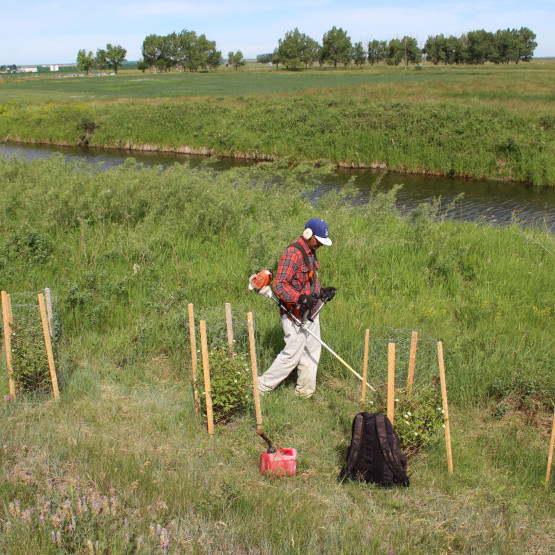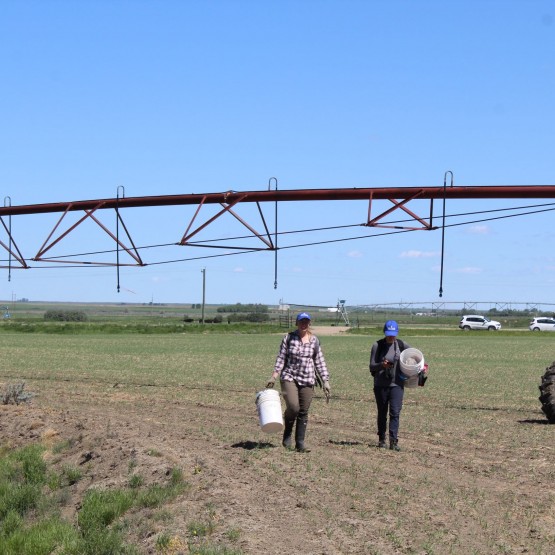Yeast site is the largest of SEAWA's restoration projects, and has been undergoing restoration since 2018. The project is in partnership with the adjacent landowner, who previously ran a tame pasture grazing operation, but has since converted to growing forage crops. SEAWA accesses the riparian area through their land.
The site is located approximately 30 km Southwest of Medicine Hat, near the hamlet of Seven Persons. The current extent of SEAWA's operation on site covers nearly a kilometer of bank on Seven Persons Creek.
Since 2018, SEAWA has planted several hundred native shrubs at Yeast site, and has been operating several applied research experiments on the control of leafy spurge (Euphorbia esula), an invasive plant that is present there. As of 2021, around 610 shrubs have been planted at the site, and the extent of leafy spurge infestation in the planted area is noticeably reduced.
As of 2022, the initial project funded through the Watershed Resiliency and Restoration Program (WRRP) and planted in 2018/19 has come to an end and those original shrubs are now mature. SEAWA continues to maintain and monitor the site, and has continued with planting native species and implementing new applied research beyond what was implemented initially.

Native species planted at Yeast site include:
- Chokecherry (Prunus virginiana)
- Red Osier Dogwood (Cornus sericea)
- Thorny Buffaloberry (Shepherdia argentea)
- Saskatoon (Amelanchier alnifolia)
- Wolf Willow / Silverberry (Elaeagnus commutata)
- Sandbar Willow (Salix exigua)
- Golden Currant (Ribes aureum)
- Green Ash (Fraxinus pennsylvanica)
- Plains cottonwood (Populus deltoides)
- Silver Sagebrush (Artemisia cana)
Restoration Process
Applied Research: Leafy Spurge

The Yeast site is home to a substantial infestation of leafy spurge (Euphorbia esula), a noxious weed that plagues riparian areas all over southern Alberta. To help improve the chance of survival of our shrubs, and develop new best management practices (BMPs), we currently have four different applied research experiments for control of leafy spurge.
Three of these experiments involve digging out leafy spurge, and planting native vegetation in its place. The vegetation SEAWA is using for these experiments are wolf willow shrubs, silver sagebrush, and a native grass seed mix. Data collection is done throughout the growing season, measuring the root length, plant height, and flower number of leafy spurge plants in experimental plots. The fourth experiment has several wooden palettes placed on top of leafy spurge patches, to see if blocking sunlight has an effect on root growth. Learn more!
Challenges
A significant challenge on this site is the competition that newly planted shrubs face, both from native and non-native plants. Native species such as Wood's rose (Rosa woodsii), wild licorice (Glycyrrhiza lepidota), and reed canary grass (Phalaris arundinacea) have weed-like behaviors that can cause them to compete directly with SEAWA's shrubs. Because of this, staff regularly mow around the shrubs, and hand weed within their cages.
In addition to the native sources of competition, there are many non-native and invasive species present at this site that pose a threat of their own. Some of the invasive and introduced species present on site include:

- Leafy Spurge (Euphorbia esula)
- Canada Thistle (Cirsium arvense)
- Smooth Brome (Bromus inermis)
- Japanese Brome (Bromus japonicus)
- Crested Wheatgrass (Agropyron cristatum)
- Alfalfa (Medicago sativa)
- Common Burdock (Arctium minus)
- Annual & Perennial Sow Thistle (Sonchus spp.)
- Lamb's Quarters (Chenopodium album)
- Flixweed (Descurainia sophia)
- Stinkweed / Field Pennycress (Thlaspi arvense)
- Shepherd's Purse (Capsella bursa-pastoris)
- and many many more
There are many natural constraints that make restoration challenging as well. These include, damage from wildlife, lack of moisture, and erosion.



























